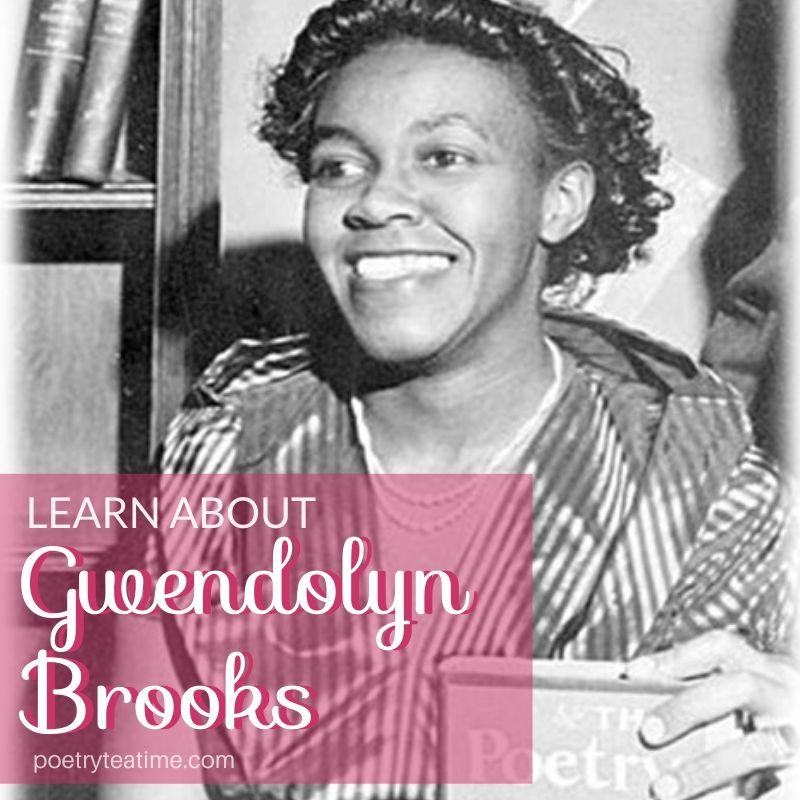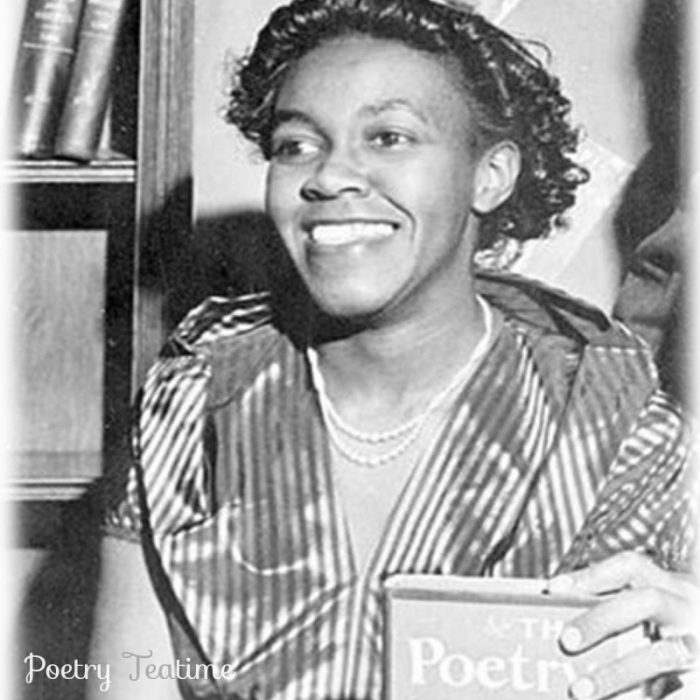Gwendolyn Brooks was one of the most influential poets and activists of the 20th century. She was the first African American to receive the Pulitzer Prize for poetry. Brooks wrote about the Civil Rights movement and the problems black people faced, especially in inner cities like her hometown, Chicago. Let’s celebrate Brooks by learning more about her work!
[This post contains Amazon affiliate links. When you click on those links to make purchases,
Poetry Teatime receives compensation at no extra cost to you. Thank you!]
Gwendolyn Brooks (1917–2000) wrote over twenty books of poetry during her career. She was the first black woman to be named US Poet Laureate (then known as poetry consultant to the Library of Congress).
Did you know…
- In addition to her poetry, Brooks also wrote a novel, her autobiography, and edited collections.
- She published her first poem, “Eventide,” at age 13! By the time she was 16, Brooks had published over 75 poems.
- Brooks read her poetry in prisons, schools, and hospitals. She even read to President Kennedy.
- She encouraged young people to write poetry by teaching workshops and funding poetry contests.
- Brooks wrote about social issues like racism and sexism. Some of her poems focus on describing the problems she saw around her in her urban neighborhood, while others offer hope for change.
Now let’s take a look at some of Brooks’s fascinating poetry. Read these poems aloud, then discuss them using the questions below!
“Corners on the Curving Sky”
Our earth is round, and, among other things
That means that you and I can hold
completely different
Points of view and both be right.
The difference of our positions will show
Stars in your window I cannot even imagine.
Your sky may burn with light,
While mine, at the same moment,
Spreads beautiful to darkness.
Still, we must choose how we separately corner
The circling universe of our experience
Once chosen, our cornering will determine
The message of any star and darkness we
encounter.
Discuss:
- Think of a time when you disagreed with someone else’s opinion. Do you remember any of the points the other person made? How did the conversation end? Now, try to imagine the conversation from their point of view. What life experiences have they had that make the topic important to them? What difference does their opinion about the topic make to their lives?
- What do you think Brooks means by “darkness”? Are there times in your life that seem “dark” to you? How do those moments affect your thoughts, feelings, and opinions?
- To help you visualize the metaphor that Brooks is using, take a look at this global weather map from Earth Wind Map. Picture other people’s opinions as different places around the world. Their experiences are different just because of where they are. How do you think where you live or how you grew up affects your own perspective?
“We Real Cool”
The Pool Players.
Seven at the Golden Shovel.
We real cool. We
Left school. We
Lurk late. We
Strike straight. We
Sing sin. We
Thin gin. We
Jazz June. We
Die soon.
“We Real Cool” is one of Brooks’s most famous poems. In it, she talks about the rebellious young people who play pool at the Golden Shovel. She takes on the voices of these teens. While most of the poem seems like a celebration of freedom, the final words warn of the dangers that youth face. Being “cool,” she suggests, won’t last forever.
Even though the poem is so short, Brooks packs it with powerful images and emotions. With your teens and older kids, discuss:
- What line of the poem stands out most to you? Does the poem surprise you at all?
- Why do you think Brooks used the voices of these teens to tell her poem? Does that affect how you read it?
- Brooks was concerned about the teens she wrote about. What concerns do you have about the world? Do you think poetry can help in the process of healing and reconciliation?
- Write your own poem modeled on Brooks’s. Follow her pattern of a short sentence and the last word “We” on each line. For an extra challenge, add your own twist to the end of your poem.
It’s important to read the work of poets like Gwendolyn Brooks, who use their poetry to comment on social issues and try to create change in the world.
Discuss together:
- What is one problem in the world that you care about?
- Do you think that poetry could help raise awareness of the problem or even be part of the solution?
Don’t forget to find more books and poems to read with our suggestions below, and enjoy celebrating Gwendolyn Brooks with your teatime today!
Other Books & Poems to Read
During your teatime, be sure to read and enjoy more of Brooks’ poetry!
Bronzeville Boys and Girls, by Gwendolyn Brooks (a picture book illustrating Brooks's poem about the lives of black children in an urban neighborhood)
We Are Shining, by Gwendolyn Brooks (a picture book and poem celebrating everyone’s uniqueness)
A Song for Gwendolyn Brooks, by Alice Faye Duncan (a biography in poetry about Brooks’s childhood)
Exquisite: The Poetry and Life of Gwendolyn Brooks, by Suzanne Slade (another poetic biography, with selections from Brooks’s poems)
Take a look at these other poems, too:
- “The Bean Eaters”: Brooks describes an old couple’s life. She talks about how important small things can be.
- “Beverly Hills, Chicago”: In this poem, Brooks compares the experiences of people in a wealthy area of Chicago with the poor. Both have troubles, but they live very different lives. (Best for teens and older kids.)
- “truth”: Brooks compares seeing the truth with having bright sunlight in your eyes, suggesting that truth isn’t always comfortable to see.
- “kitchenette building”: Brooks sets this poem in urban housing where multiple apartments share kitchenettes and bathrooms. She talks about how hard it is to have dreams when you’re focused on survival. (Best for teens and older kids.)



